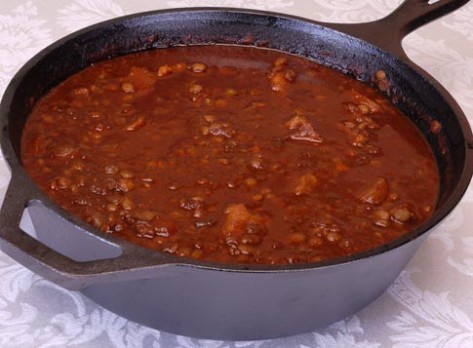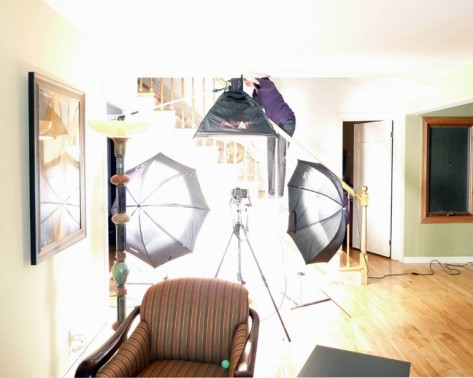Photo Tech Stuff and the Moorish Impact on Mexican Cooking

Photo by DCCC club member Melanie Considine
Melanie Considine is a fine art photographer with professional experience. Translation: she’s got the art part down and she knows what buttons to press, whether she’s using her low-tech 4 by 5-inch view camera for her artwork or her high-tech Nikon D200 for miscellaneous design projects (she’s also a web designer). Several weeks ago, to reciprocate a Greek rabbit dinner, she and her husband Matt had my boyfriend Mike and me over for dinner. Matt made homemade ciabattta bread (he is a dedicated amateur bread baker and has even built his own bread oven), and Melanie, a DCCC member, prepared Mexican food from The Art of Mexican Cooking.
The headliner of the menu was a hearty dish of lentils and tender pork with chunks of pineapple, thick slices of plantain, and a deep red and aromatic sauce of toasted chiles, broiled tomatoes, and spices. Called Lentejas en Adobo, or “Lentils with Chiles, Pork, and Fruit,” this dish, and others like it that combine sweet fruit and meat, a common pairing in the fruit-growing regions of Mexico, has its roots in Moorish Spain, according to Diana Kennedy. Both Melanie and I agreed that it is the pineapple that brings this dish to life. Nearly the same size as the chunks of pork, and enveloped in a thick, red-brown sauce, the pineapple were visually muted; it is in the mouth where they made their impact, providing a surprising burst of juicy, sweet-tart fruit with every bite and balancing the otherwise meaty or starchy ingredients with a touch of lightness, making the dish very moreish, as Diana Kennedy, a Brit, might say.
Knowing of Melanie’s photography work, I asked her if we could shoot the main dish for the blog that evening. Having a full set of strobe lights, the lack of natural light was not a problem for her. I never mastered strobe lights—too many buttons—but I understand the practicality (and control) they provide for the professional photographer. Melanie set up the lights and a simple setting (white tablecloth over table) to document the dish. Here are two strobe factoids that I learned that evening from Melanie:
1. Flashes, including strobes, which are a type of flash, are synced. Some have receivers that can be triggered by other camera flashes. So when I photographed Melanie’s set up, shown below, the flash automatically set off the strobes in her impromptu studio, which caught me by surprise. The intensity of the light, brighter than Times Square, but brief, like fireworks, flooded the room. It was kind of fun to click away on my little Panasonic Lumix to get rushes of light shows, though eventually I turned the flash off on my camera. (This is not helpful to the photographer.)

Melanie’s impromptu studio set up to photograph our dinner. Melanie can be seen on the stairs, adjusting the height of the softbox.
2. Melanie mentioned that with a high power strobe, as opposed to natural light, it’s often not possible to step the aperture down, making it difficult to create a shallow depth of field. This is only possible when using natural light or lower intensity incandescent lighting, the latter of which can present color balance issues. Happy news to my ears. Now if someone asks why I never mastered strobe lights, I can make my ignorance sound as if it were in fact a conscious, deliberate decision, “No,” I will say, “because I enjoy working with natural light and I prefer using a shallow depth of field to emphasize the three-dimensionality of food,” which is all true.

To allow me to photograph the set-up, and avoid the blinding light of syncing flashes, Melanie turned the strobes off and the incandescent modeling lights on, and I turned the flash off my camera—thus the warm glow of tungsten light in this photo.
